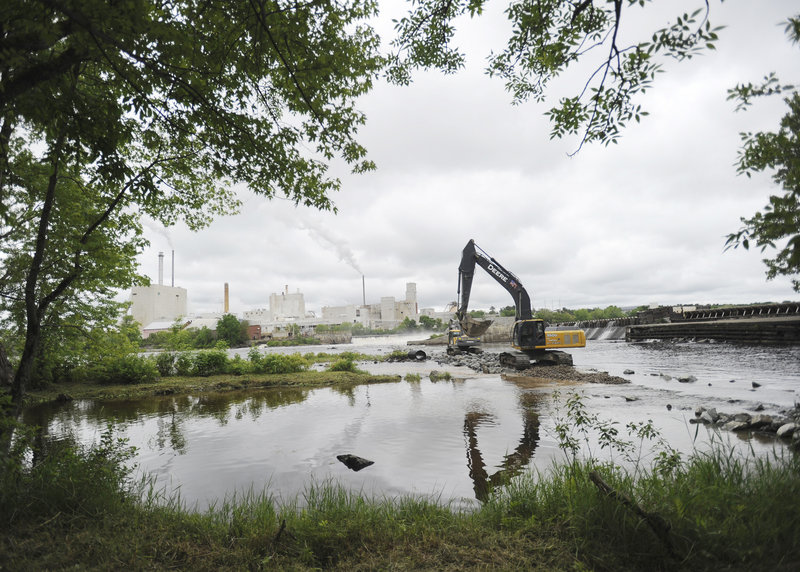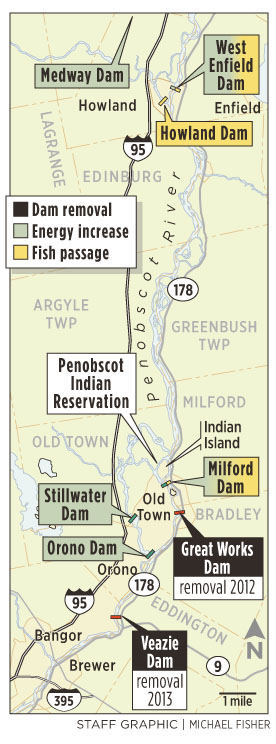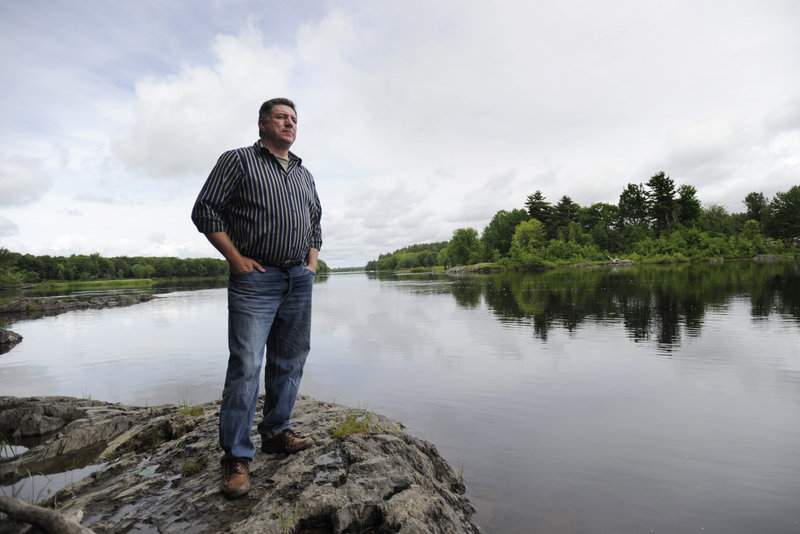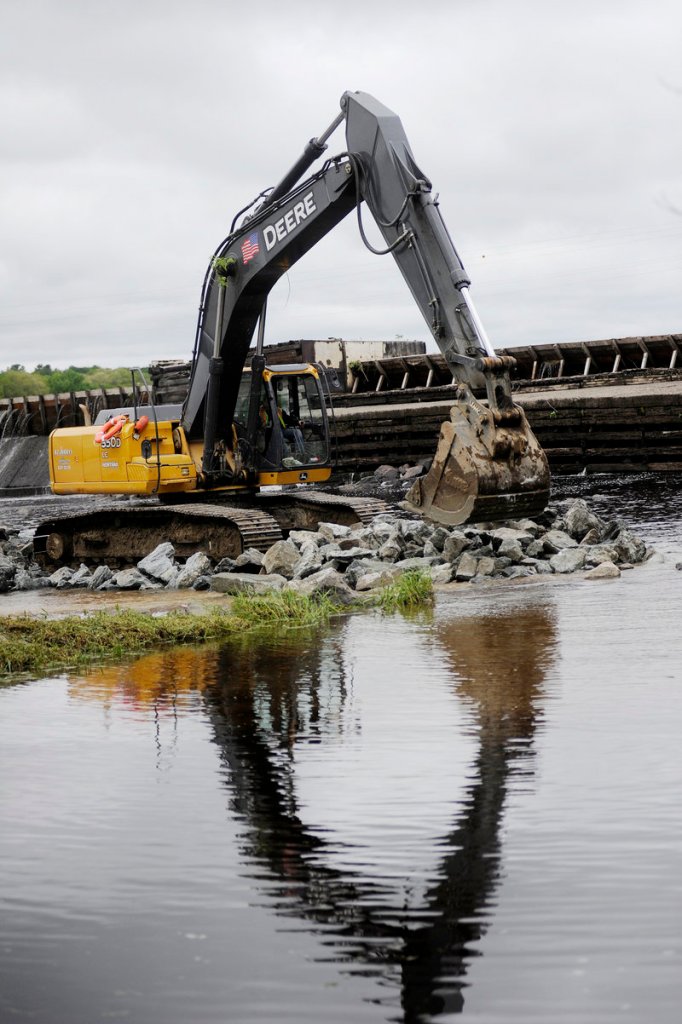After 13 years of legal, political and engineering work, the largest-ever river restoration project in eastern North America begins Monday morning, when a 40-ton excavator aims its percussion hammer at the defunct concrete fishway of the Great Works Dam on the Penobscot River.
The $62 million project, to be completed in 2014, includes removing two dams and improving fish passages at two others. In the end, 1,000 miles of the Penobscot and its tributaries will be accessible to Atlantic salmon and other native sea-run fish for the first time in nearly two centuries.
Maine has removed 18 dams since 1999, when the Edwards Dam on the Kennebec River was demolished. But the impact of those projects is modest compared with the restoration of the Penobscot, Maine’s largest river, says Amy Kober, a spokeswoman for American Rivers.
Kober says the Penobscot River project is viewed as a model for other river basins around the world because it improves fish access without cutting the amount of power hydroelectric companies can produce.
“From our perspective, the Penobscot project is one of the most significant river restoration efforts our country has ever seen,” she says.
Ken Salazar, secretary of the U.S. Department of the Interior, will be among the dignitaries speaking at a 10:15 a.m. news conference at the dam Monday. Salazar will also attend a community luncheon on Indian Island sponsored by the Penobscot Indian Nation, which played a critical role in the project.
Hundreds of people are expected. Because public access to the dam is limited, organizers are encouraging people to watch the news conference live-streamed on a 16-foot-wide screen in Sockalexis Hall, the bingo hall on Indian Island. There will also be van tours to the dam site.
Bill Taylor, president of the Atlantic Salmon Federation, describes the project as the best, and perhaps last, chance to restore a major run of wild Atlantic salmon in the United States. “This may well turn out to be the most important day for Atlantic salmon in the past 200 years,” he says.
‘BAD FALLS WITH THE BAD CARRY’
The Great Works Dam is a 1,020-foot-long mass of concrete, timber and cribwork situated on a bend in the river between Old Town and Bradley, just downstream from Indian Island, the Penobscot Indian reservation. The river drops 17 feet over a third of a mile and without the dam, there would be rapids.
The Penobscots called this stretch of river “the bad falls with the bad carry,” because it has a difficult portage, says James Eric Francis Sr., tribal historian.
The original Great Works Dam was built in the 1830s as a “wing dam,” parallel to the shore, to provide water for sawmills. It was partially demolished around 1887, when the current dam was installed by the Penobscot Chemical Fibre Co., the first pulp mill on the river.
The dam and generating facilities were sold several times over the next century, and purchased by PPL Corp. in 2000. The dam was sold to the Penobscot Trust in 2010 as part of the landmark river restoration agreement.
The Veazie Dam — scheduled for demolition in 2013 and 2014 — is eight miles downstream from Great Works and is the last physical barrier to juvenile salmon reaching Penobscot Bay and the sea. Scientists monitor returning salmon at fishways and traps at the Veazie Dam. Most are taken to hatcheries or trucked upriver.
Before construction of dams on the river, an estimated 75,000 to 100,000 adult salmon spawned on the Penobscot annually. Last year, scientists counted 3,100 salmon, the best run in the past 30 years. Nearly all of the fish were raised in hatcheries.
Removing the dams will allow a self-sustaining run of 10,000 to 12,000 fish in 10 to 15 years, Taylor says.
For a century, the Penobscot Indian Nation has been unable to exercise its tribal rights to catch fish such as Atlantic salmon because the river is virtually devoid of native sea-run fish. In various treaties, the tribe retained the right to subsistence-fish for salmon and other species that are otherwise illegal to harvest.
The Penobscots’ status as a sovereign Indian tribe was a crucial factor in the settlement agreement, because it gave the tribe leverage during the federal license renewal process for the hydroelectric dams in the watershed.
Collaborating with environmental groups, the tribe argued that the federal government is required to ensure proper management and protection of tribal natural resources, such as the right to harvest fish within the waters of its jurisdiction.
The tribe’s arguments — initially contested by then-dam owner PPL Corp. — threatened the company’s ability to continue winning licenses from the federal government to produce power on the river.
A deal was reached in 2004 that gave the dam owners certainty over future federal regulation and allowed them to make investments in other hydro dams in the river basin. The agreement called for PPL to sell the Veazie, Great Works and Howland dams to the Penobscot River Restoration Trust for $24 million. In return, the power company was allowed to increase power generation at six other dams along the river, offsetting the losses incurred when the Veazie and Great Works dams are no longer in use.
In addition, two dams will get significantly improved fish passages: an elevator to lift fish over the Milford Dam and a fish bypass at the Howland Dam.
According to a Penobscot Indian legend, a “frog monster” once sat in a great river and blocked the movement of water, causing the people to get sick and die. When Glooscap, a legendary hero in American Indian lore, smashed the frog with a tree, the tree was transformed into the Penobscot River and its branches into tributaries.
“That’s how the Penobscot River was born,” Francis says. “By removing these frog monsters today — these dams — it allows the river to become healthy again and the fish species to come back to reservation waters.”
HOPING FOR LITTLE DRAMA
Over the past two weeks, work crews have been building an access road to the dam out of rocks. A large excavator on Monday will break apart the fishway near the middle of the dam and possibly remove a piece of the dam itself to create a spillway, if the river is low enough.
The project will proceed slowly, says Jeffrey Hallett, project manager for Ellsworth-based R.F. Jordan & Sons Construction Inc., which has been awarded the $3.5 million contract. Spectators will not see a giant cascade of water spilling over a breach, he says.
“We are hoping for a little less drama,” he says.
There is limited space for viewing the removal. The Penobscot River Restoration Trust will ferry the public to the dam site in vans. People interested in seeing the demolition should contact the trust at 699-9492.
The removal of the fishway has great symbolic value because it was poorly designed and ineffective, says Laura Rose Gay, executive director of the Penobscot River Restoration Trust.
As part of the restoration project, work is expected to begin any day now on installing a state-of-the-art fish lift at the Milford Dam upriver, she says.
Two hydropower companies, PPL Corp. and Black Bear Hydro, are now major partners in the project, along with federal and state governments, the Penobscot River Restoration Trust, the tribal government of the Penobscot Indians and six conservation groups.
Funding comes from a mix of private donations, foundation grants and the federal government, primarily the National Oceanic and Atmospheric Administration and the U.S. Fish and Wildlife Service. Maine is contributing $85,000 from Land for Maine’s Future to improve public access to the river.
Organizers must still raise $9.5 million to complete the project, and they hope publicity from the removal of the Great Works Dam will spur private donations.
Gov. Paul LePage, who was invited to attend Monday’s news conference, is sending in his place Patrick Keliher, commissioner of the Maine Department of Marine Resources.
Speaking to reporters last week about the Penobscot project, LePage said dam removal is inappropriate, given that hydropower is a renewable resource and electricity prices in Maine are so high, according to the Maine Public Broadcasting Network.
“I think it’s irresponsible for our state or our country to be taking out hydro dams at this time. In fact, we ought to be putting more in,” he said.
Staff Writer Tom Bell can be contacted at 791-6369 or at:
tbell@pressherald.com
Send questions/comments to the editors.






Comments are no longer available on this story